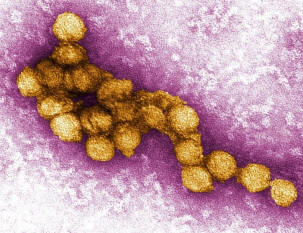 West Nile
West Nile
Microbial Diseases A to Z | Disease Home Page | Bio 406 Home Page | MicroWorld |
 West Nile
West Nile West Nile Virus, or WNV is a neurotropic single stranded RNA virus belonging to the same genus as other well-known viruses such as Zika, Dengue, and Yellow Fever. The reservoir of WNV are birds, infecting over 250 species. The primary vector of this virus are the Culex mosquitos which are able to maintain species populations through vertical transmission. When the virus load is high in a bird’s blood and a mosquito feeds, they develop their own infection which is then passed onto any subsequent animal, including dead-end mammal hosts such as horses or humans. It is the most prevalent cause of any mosquito-borne disease in the United States with over 2,400 people being infected in 2021 and 165 deaths.
Lim, S. M., Koraka, P., Osterhaus, A. D. M. E., & Martina, B. E. E. (2011). West Nile virus: Immunity and pathogenesis. Viruses, 3(6), 811–828. https://doi.org/10.3390/v3060811
Centers for Disease Control and Prevention. (2023, March 29). West Nile Virus. Centers for Disease Control and Prevention. Retrieved April 24, 2023, from https://www.cdc.gov/westnile/index.html
West Nile Virus. West Nile Virus | Johns Hopkins Medicine. (2023). Retrieved April 24, 2023, from https://www.hopkinsmedicine.org/health/conditions-and-diseases/west-nile-virus
Artist, Unknown. (2015). Picture depicting the microscopy of WNV. National Institute of Allergy and Infectious Disease. National Institute of Health. Retrieved April 24, 2023, from https://www.niaid.nih.gov/diseases-conditions/west-nile-virus.